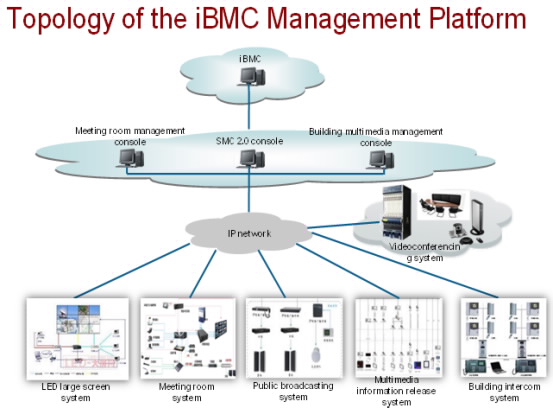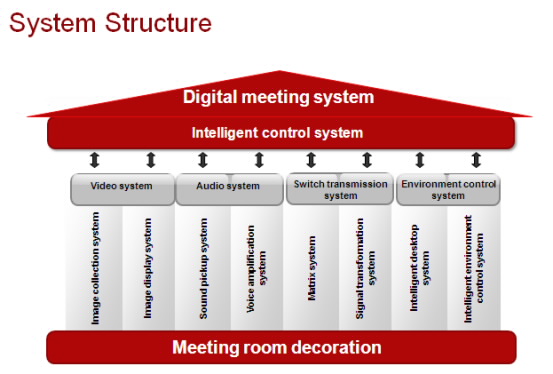Based on incomplete statistics, the current intelligent building multimedia solutions involve more than 20 subsystems, including:
- Multimedia digital meeting system
- Building self-control system
- Video surveillance system
- Anti-theft alarm system
- Fire alarm system
- Public broadcasting system
- Access control system
- UPS monitoring system
- Floodlighting system
- Leakage detection system for an equipment room
- Elevator system
Most of these systems are set up separately. If technical routes, system devices, and control software are also deployed independently in these systems, separation between software and hardware, between systems, and between system operation and management will be caused.
In Huawei Intelligent Building Multimedia Solution, iBMC uses an integrated common high-speed communication network to share information, resources, and tasks and deliver centralized and distributed monitoring, control, and management on a unified human-machine interface.
Figure 1 Topology of the iBMC platform

Figure 2 System structure

Characteristics of iBMC
A.Strong stability
iBMC strictly complies with the intelligent building standard and security design specifications. It can ensure the security of people, devices, and materials inside buildings, prevent access of unauthorized users, avoid personal injury caused by any device operations, and keep long-term proper operation of a weak current system.
By predefining and configuring various alarms and risks, the comprehensive association function of iBMC automatically performs interior adjustment and actions based on predefined plans and specific association measures in the case of an alarm.
B.Unified management
iBMC is oriented to multiple vendors, and various protocols and applications. It supports integration of different devices, subsystem interfaces, protocols, system platforms, application software, construction environments, and operation management modes to implement interconnection and interoperation between subsystems. The main target of iBMC is to allow users to access each subsystem easily and flexibly.
iBMC allows unified integration management with the following features:
1.Standard design
2.Mature software and hardware
3.Open and universal technical standards
4.Reserved upgrade interfaces and necessary backup
C.Ease of use
Taking full account of the management mode, operators, and practical operation techniques, iBMC provides an intuitive user interface, and is easy to operate and maintain.
Characteristics of the Digital Meeting System
A.End-to-end meeting management system
1.Reserves meetings in web mode, collects device information, and releases device fault information, reservation information, and meeting notification before a meeting.
2.Shields wireless signals, alert for device faults, and troubleshoot faults remotely during a meeting.
3.Releases fault recovery information and plays end music after a meeting.
Allows users to reserve, query, approve, release, and collect statistics of meetings, and control and manage meeting rooms.
B.Meeting reservation system
The meeting reservation system is tailored for customers of intelligent buildings to solve the problems on meeting room resource management. It has three main functions: meeting room state query, meeting reservation management, and usage statistics.
(1)Rich implementation means
This system allows users to manage meeting reservation using personal computers, meeting reservation screens, or smartphones when they are in office, at home, or traveling.
(2)Intelligent group memorizing
This system implements humanized management for different classes of meeting participants through intelligent meeting convention analysis and group memorizing. It allows meeting holders to send meeting notification and minutes to invitees using emails or text messages by one-key operation.
(3)Easy to operate as Pad
The scene meeting reservation system has a simple GUI with tooltip for buttons, which brings a perfect and simple use experience as Pads for users.
Huawei Intelligent Building Multimedia Solution applies to government, traffic, electricity, hotels, medical treatment, schools, business buildings, luxury villas, and high-grade residential districts.
With the advanced computer control techniques, rich and flexible control and management software, and energy-saving programs, the solution allows electromechanical facilities of building or building groups to run in an orderly, harmony, and scientific manner. This ensures a cozy working environment inside buildings, saves energy, and reduces maintenance and management workload and operating cost.


